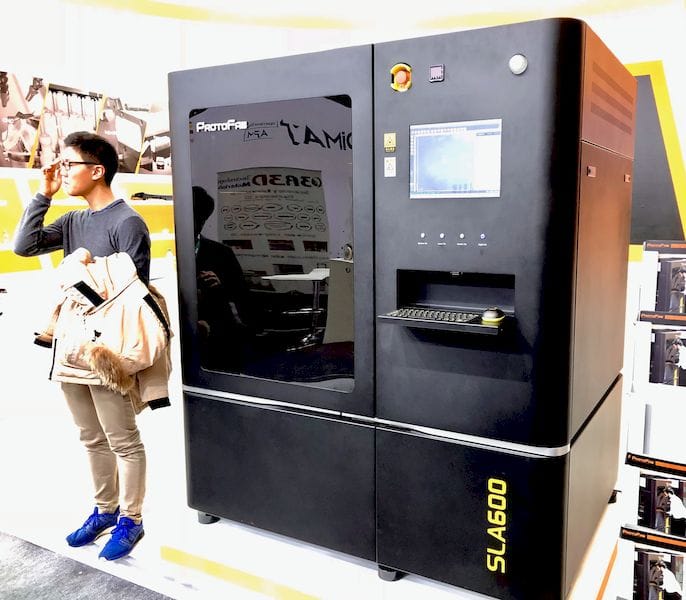![The ProtoFab SLA600 industrial 3D printer [Source: Fabbaloo]](https://fabbaloo.com/wp-content/uploads/2020/05/image-asset_img_5eb09dc045520.jpg)
You may have not heard of ProtoFab, but they have long experience in 3D printing.
The company is a spinoff of Duch Group, a provider of rapid prototyping services in China since 1996. In 2014 the company decided to get into industrial 3D printing and launched the ProtoFab project, which resulted in the company we see today.
The company currently markets a line of SLA equipment in various sizes, each capable of producing highly accurate prints in a wide variety of resins. The smallest machine, the ProtoFab SLA150, has a build volume (surprise) of 150 x 150 x 150 mm, whereas their current largest device is the massive ProtoFab SLA1100, which has a build volume of 1200 x 750 x 550 mm — that’s quite large.
The machine accuracy is good, although it drops to 0.2mm in the largest machine, likely due to the size of the unit’s build volume. The galvanometer-powered lasers’ hot spot ranges in size from 0.12 to 0.20mm, simply because its size changes as it angles off towards the sides of the build layer.
Currently the SLA1100 boasts twin lasers for double speed 3D printing, but we’re told that in the future they may be able to equip the device with up to six lasers. That is perhaps the most lasers we’ve heard of in a single SLA machine, and they should dramatically speed up print operations — ideal for production use.
While the machine and its software is carefully tuned for using ProtoFab materials only, it is entirely possible to use other third party resins in their equipment. However, the print parameters must be tuned by the operator, and the resin must be reactive in the 355nm wavelength range.
The machines are, as you might expect, used extensively in Duch Group’s rapid prototyping service. Apparently they now operate around 35 industrial 3D printers in that operation.
![Control station on the ProtoFab SLA600 [Source: Fabbaloo]](https://fabbaloo.com/wp-content/uploads/2020/05/image-asset_img_5eb09dc09405c.jpg)
Recently they’ve added changes to their 3D printer operating software that permits changes in laser power, enabling more flexible use of the device. This is said to provide an ability to speed up prints by 3X.
The machines all come with a rather long warranty period of two years, something we don’t often see on 3D printing equipment. Pricing of the machines ranges from US$75K for the smaller machine, to US$200K for the SLA600 mid-range model, to US$430K for the largest SLA1100 model.
One interesting aspect of the larger machine is that it requires a minimum amount of resin to operate. Apparently you will need 250kg of resin, as that is the size of its build chamber, or it won’t work. This amount of resin would cost US$45K alone, but is included in the installation price.
For large-scale SLA production, you might want to consider looking at the ProtoFab line of industrial 3D printers.
Via ProtoFab











FELIXprinters has released a new bioprinter, the FELIX BIOprinter, which is quite a change for the long-time 3D printer manufacturer.